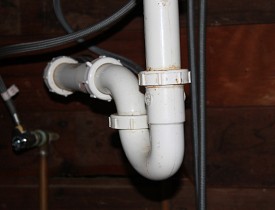How to Unclog Your Sink's U-Bend
 If you have a slow-draining sink, don’t whip out the drain cleaner or the plumber’s phone number just yet (using drain cleaners with abandon is one of the 10 plumbing mistakes people often make). You may be able to fix it yourself, and you don’t need any special plumbing skills or tools, beyond a bucket or a bowl and a little bit of time. After you’ve unclogged a slow-draining sink once, you’ll have the confidence to do it again in the future and, just maybe, you’ll feel comfortable branching out into more advanced plumbing, like learning some freezing pipe solutions.
If you have a slow-draining sink, don’t whip out the drain cleaner or the plumber’s phone number just yet (using drain cleaners with abandon is one of the 10 plumbing mistakes people often make). You may be able to fix it yourself, and you don’t need any special plumbing skills or tools, beyond a bucket or a bowl and a little bit of time. After you’ve unclogged a slow-draining sink once, you’ll have the confidence to do it again in the future and, just maybe, you’ll feel comfortable branching out into more advanced plumbing, like learning some freezing pipe solutions.
What is a U-bend?
Meet the P-trap, also known as the U-bend, a critical part of your sink’s drainage anatomy. If you look under the sink, you’ll notice that instead of going straight down, the pipe makes a U-shaped bend before leading off to your septic or sewer line. The trap is designed to prevent backflow, and, critically, to ensure that sewer gases don’t rise up out of the sink.
When your sink is clogged
The U-bend is a low point in the plumbing, and as its alternate name implies, it tends to trap things. It helps to know how to take one apart in case you drop something down the sink, but it’s also useful to know how to do it in case your sink starts to drain slowly. If you notice that your sink appears to be clogged, there’s a good chance the problem lies in the U-bend, and you should be able to fix it with some short work.
How to unclog the U-bend
Start by clearing out the space under your sink, because some spillage may occur, and you want room to work. Grab a bucket or a large bowl and place it under the U-bend before carefully unscrewing the threaded caps on either end of the bent length of pipe. These should come undone easily unless the plumbing hasn’t been serviced in a while; if they’re sticking, add a little bit of lubricant to help them pull apart more easily.
If your sink was totally clogged, watch out, because a rush of water will flood into the bucket as you clear the line. Otherwise, you may notice some water in the bent section of pipe, so be careful to upend it over the bucket and give it a chance to drain. You should also notice some debris, like hair, dirt, and other things that may have fallen into the drain and gotten trapped in the U-bend.
Clear the bent section of pipe thoroughly before reattaching it the same way you took it apart, and test out your sink. Make sure there are no leaks around the connections and that the sink drains smoothly. If it’s still sluggish, you have a clog further down the line, and it’s time to start considering some triage. There may be a problem further along the line that requires a plumber’s attention, such as a root that’s grown through the line.
Important info when you call a plumber
When you call a local plumber nearby for help with a clogged sink (or bathtub, which also has a P-trap) or even with a pressure assist toilet, make sure to have some information available to help the plumber diagnose the problem more quickly. Mention how long you’ve been noticing a drainage problem and what you did to fix it, and take note of any changes; if the sink started draining better but not entirely after you cleared out the trap, for example, tell the plumber this.
And don’t be afraid to ask your plumber questions before the job starts to find out how much it might cost and how long the procedure might take. You can also double check the plumber’s license number with the state board to confirm that your plumber is registered and check for any outstanding complaints.
Updated June 22, 2021.
Looking for a Pro? Call us (866) 441-6648

Plumbing Average Costs
Plumbers Experiences

Four Essential Points That Helped Me Install The Best Toilets

Replacement Water Heater For Our Condo At The Lake



